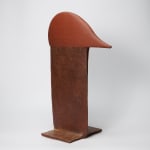Suzuki Osamu 鈴木治 1926-2001
H62.3 x D25.8 x W38.8cm
With Signed Wood Box
Further images
-
(View a larger image of thumbnail 1
)

-
(View a larger image of thumbnail 2
)

-
(View a larger image of thumbnail 3
)

-
(View a larger image of thumbnail 4
)

-
(View a larger image of thumbnail 5
)

-
(View a larger image of thumbnail 6
)

-
(View a larger image of thumbnail 7
)

-
(View a larger image of thumbnail 8
)

-
(View a larger image of thumbnail 9
)

-
(View a larger image of thumbnail 10
)

-
(View a larger image of thumbnail 11
)

-
(View a larger image of thumbnail 12
)

-
(View a larger image of thumbnail 13
)

As a co-founder of the avant-garde group Sodeisha 走泥社 in the 1940s, Suzuki Osamu was integral to the modernization of Japanese art after World War II. He and his peers were the first to create ceramic sculptures that functioned solely as aesthetic objects rather than functional items, and with this whimsical piece he takes his work fully into the realm of sculpture. Entitled Cap Of Cloud, this piece has the unique, playful quality of Japanese cartoons. One can imagine the artist arriving at this organic form after a day spent looking up at the sky and forming mental shapes from the clouds. Suzuki has realized this work in his signature Shigaraki clay, that he has overlaid with several layers of red englobe and then sprayed with ash to achieve the two distinct red and reddish-brown colors. Suzuki's forms and colors are rooted in nature, both of the earth and of the sky. An awareness of the natural world and of the changing of the seasons lies deep within the very soul of Japan. The Zen master Dogen's poem illustrates these seasonal cycles:
"In the spring, cherry blossoms,
In the summer the cuckoo,
In the autumn, the moon, and in winter the snow, clear, cold."
The bounty of nature in Japan ensures that each new season brings a different kind of beauty, which has instilled in the Japanese people the inherent knowledge of the cycles of nature. Suzuki channels this heritage in his work, pulling from his observations of the natural world to create wholly original, playful sculptural objects.
One of the most widely respected potters of the late twentieth century, Suzuki enjoyed a long, prolific, and innovative career. His work can be found in numerous private and public collections, and the National Museum of Modern Art, Kyoto organized a large retrospective of his work in 2013.
- X
- Tumblr













